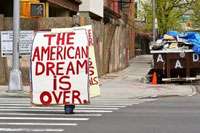|
|
USA and Britain Pay 10 Trillion for Illusion of Stability
By Vitaly Salnik
- September 14, 2009
 World’s leading economies have already spent over $10 trillion on the anti-crisis struggle. This astronomical number makes up $10,000 per each tax-payer, economists with the International Monetary Fund said. The United States and Britain take the lead in terms of the anti-crisis spending. World’s largest financial centers – New York and London - are located on the territories of these two countries: it is simply impossible to overestimate the significance, which these two centers play in the formation of the crisis.
The largest bailout programs were passed in the USA and Britain, the BBC said. The States used $3.6 trillion - a quarter of the nation’s annual GDP - to win the fight with recession. The crisis spending thus makes up some $10,000 per each tax payer in the United States. Britain, which is obviously a much smaller state geographically and economically, has already wasted $2.4 trillion, which makes up 94 percent of the annual GDP – with $30,000 per each tax-payer.
Bailout programs did not make the largest article of expenditure. The Federal Reserve System became the key supplier of liquidity in the United States: the FRS’s balance increased from $800 billion to $2 trillion within a year. As a result, the USA’s principal financial regulator has started using the methods of extra cheap money. The cost of money in the USA has already hit a historical minimum. Will this practice be successful? Alan Greenspan was providing extra cheap money to nearly everyone, which eventually created a huge bubble on the real estate market of the United States.
The world financial sector suffered from the crisis most: its losses are evaluated at $4 trillion. Two-thirds of this amount fall on world’s largest banks, such as Citigroup and RBS, which makes it very easy to find the causes of the crisis. The banks wrote off $1.8 trillion only because of subprime mortgage problems – those loans triggered the current setback.
It is worthy of note that formally, the beginning of the world crisis is connected with the collapse of another giant – Lehman Brothers. The specific warning was made in August of 2008, when Harvard economist Kenneth Rogoff stated during a press conference in Singapore: “We’re not just going to see midsized banks go under in the next few months, we’re going to see a whopper, we’re going to see a big one—one of the big investment banks or big banks.”
Lehman Brothers filed for bankruptcy a month later.
The markets of the world were shocked with the collapse of Lehman Brothers. The bubble burst.
The hasty conclusions about the end of the crisis, which some experts may make, are based on false statistics data and stock market indexes. Stock markets in their turn are guided by those statistics data.
As a matter of fact, it is still unclear when the world credit market is going to stand up on its feet. Britain’s national debt will double during the forthcoming five years to $16.51 trillion, RBC reports. The foreign debt of the USA will hit the mark of $12.1 trillion as of the end of 2009.
|
|
|
|
|
|  |
|
 World’s leading economies have already spent over $10 trillion on the anti-crisis struggle. This astronomical number makes up $10,000 per each tax-payer, economists with the International Monetary Fund said. The United States and Britain take the lead in terms of the anti-crisis spending. World’s largest financial centers – New York and London - are located on the territories of these two countries: it is simply impossible to overestimate the significance, which these two centers play in the formation of the crisis.
World’s leading economies have already spent over $10 trillion on the anti-crisis struggle. This astronomical number makes up $10,000 per each tax-payer, economists with the International Monetary Fund said. The United States and Britain take the lead in terms of the anti-crisis spending. World’s largest financial centers – New York and London - are located on the territories of these two countries: it is simply impossible to overestimate the significance, which these two centers play in the formation of the crisis.
 We recommend
We recommend



